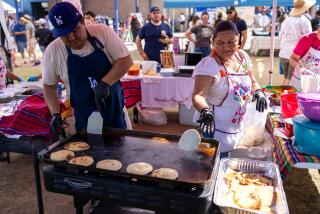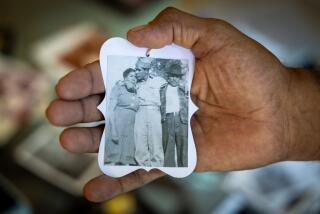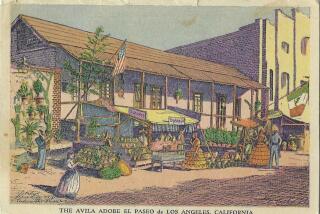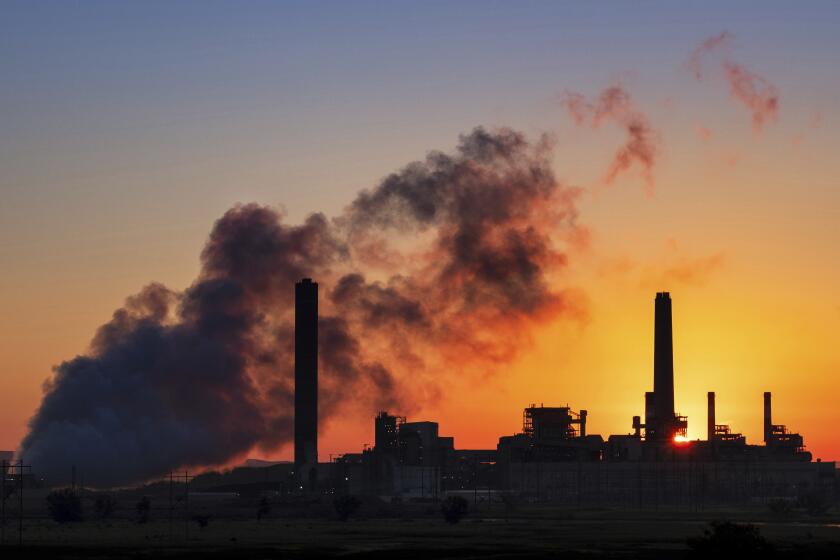Salvaging El Salvador
Collective memory in El Salvador has long been a fragile commodity. An infamous 1932 government massacre of mainly Indian peasants was officially purged from history books for decades afterward.
The countryâs brutal 12-year civil war of 1980-92 not only claimed tens of thousands of lives and razed entire villages. It also ravaged the countryâs heritage, fostering widespread amnesia about Salvadoran literature, music, indigenous culture and the performing arts.
Over the next week, an ambitious multimedia happening with the umbrella title âPreservacion de la Memoria Historica Salvadorenaâ (Salvadoran Preservation of Historic Memory) at the Los Angeles Theatre Center downtown will try to salvage some of that missing past.
Produced by L.A.-based Olin Theater Presenters, its centerpiece will be a half-dozen performances of a narrative dance-theater production, âDe la Locura a la Esperanza: From Madness to Hope.â The piece -- incorporating 30 actors and dancers, a childrenâs choir, choreography by Saul Mendez Folkloric Ballet, spoken monologues and recordings -- attempts to address the civil warâs haunting legacy while looking toward the future of Salvadorâs people, both at home and abroad. Its title comes from a report issued by the U.N. Truth Commission on the civil war.
The event, which begins today and wraps up Nov. 1, also will encompass a photo exhibition about the civil war years; a symposium on historic memory; a discussion of two of Salvadorâs most significant writers, the poet Roque Dalton and the all-around man of letters Salvador Salazar Arrue; and a show of manuscript facsimiles, photos and other artifacts examining the life and legacy of Arrue, known by his pen name SalarruĂŠ, whose most famous work, âCuentos de Barroâ (Tales of Mud), published in 1933, is regarded as an exemplar of the modern Central American short story.
--
Strong backing
Two key supporters of the weekâs activities are Cal State Northridge, which claims to operate the only college-level Central American Studies Program in the United States, and the General Consulate of El Salvador in Los Angeles. Organizers say that âPreservacionâ is easily one of the largest cultural events ever staged on behalf of the hundreds of thousands of people of Salvadoran descent living in Greater Los Angeles.
But William Flores, director of Olin Theater Presenters and the festivalâs prime mover, said the real measure of the eventâs success would be whether it reaches and speaks to Salvadorans who fled their country and have struggled to stay connected to it while assimilating to a new home. Many of these immigrantsâ children and grandchildren, born in the United States, know little or nothing of either their homelandâs rich traditions or its darkest chapters, he said.
âMemory is something that mustnât be lost,â said Flores, who also serves as LATCâs program director. âTo kill memory is to kill the human being.â
--
Internal strife
The Salvadoran civil war, pitting a U.S.-backed right-wing junta against internationally supported leftist guerrillas, was as divisive as it was catastrophic, and its polarizing effects continue to this day. More than 75,000 died in the conflict, and an additional 10,000 were âdisappearedâ and almost certainly murdered.
An estimated 1.5 million people fled the country, the majority relocating in Southern California and other U.S. cities. An accord was signed in 1992, ending hostilities but leaving many social and political aspects of the warâs aftermath unresolved.
Roger Lindo, an author and reporter for the La Opinion newspaper here, said at a news conference that the dispersal of the Salvadoran population had diffused its collective identity. âItâs a nation thatâs fragmentized, atomized in all parts of the world,â he said.
In El Salvador, as in other parts of Latin America, artists and writers not infrequently have performed the work of historians and archaeologists, exhuming the skeletal remains of painful events and placing them in the light for public consideration. Both Dalton and Salarrue, for example, authored influential works dealing with the 1932 massacre, the memory of which the government was trying to ignore if not actively suppress.
--
Making progress
Flores said that he had been trying for years to enlist the help of El Salvadorâs right-of-center ruling party officials to put together an event such as âPreservacion.â It was only with the recent ascension in El Salvador of a new left-leaning political administration that the consulate here has agreed to participate, he said. A news conference announcing the weekâs events was held at the Salvadoran consulate on Wilshire Boulevard, with consulate personnel in attendance.
Another Salvadoran institution actively aiding the L.A. event is the Museo de la Palabra y la Imagen (Museum of the Word and Image) in San Salvador, a privately funded nonprofit that holds a large archive of extremely rare manuscripts, photos, films, audio recordings and other materials relating to the war. Its founder, Carlos Henriquez Consalvi (known by his nom de guerre Santiago), who also helped establish the rebel underground Radio Venceremos broadcasting network, will be a panelist at Saturdayâs symposium.
Beatriz Cortez, an associate professor and coordinator of CSUNâs Central American Studies Program, said that over the years a number of programmed events at the San Fernando Valley college campus and other local venues have dealt with Salvadoran politics. But few have focused on culture, she said.
Societies that have experienced prolonged episodes of traumatic violence often have difficulty confronting their ghosts, Cortez said. Many of her studentsâ Salvadoran parents were reluctant to discuss the war, she said. But their children are curious.
Now, she said, that long-delayed dialogue can happen through culture.
âWe have a lot of singers and pop artists coming to Los Angeles, but we donât have many plays,â she said. âI think itâs important to have these spaces because we never really get rid of those demons. Itâs important, itâs productive and itâs healing.â
--
--
(BEGIN TEXT OF INFOBOX)
--
Preservation of historic memory
--
Where: All events take place at the Los Angles Theatre Center, 514 S. Spring St.
What: âDe la Locura a la Esperanza: From Madness to Hopeâ
When: 8 p.m. tonight-Sat. and Oct. 30; 3 p.m. Sun. and Nov. 1; 6 p.m. Oct. 31
Price: $20; $15 students, seniors
--
What: Exhibitions: âFrom War to Peaceâ (photos); âThe Legacy of Salarrueâ (manuscripts, images, objects and paintings); âGritos desde lo Invisible (Cries from the Invisible), art installation by Claudia Bernardi
When: Galleries open an hour before, after and during theater performance times
Price: Free
--
What: Cultural Symposium: Preservation of Historic Memory
When: 6 p.m. Saturday
Price: Free
--
What: Panel discussion on Salvadoran literature, featuring Salarrue and Roque Dalton
When: 6 p.m. Oct. 30
Price: Free
Info (all events): (213) 489-0994;
www.thelatc
More to Read
Sign up for Essential California
The most important California stories and recommendations in your inbox every morning.
You may occasionally receive promotional content from the Los Angeles Times.











